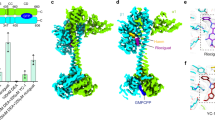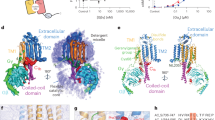Abstract
Adenylyl cyclases (ACs) are membrane bound enzymes that catalyze the production of cAMP from ATP in response to the activation by G-protein Gαs. Different isoforms of ACs are ubiquitously expressed in different tissues involved in regulatory mechanisms in response to specific stimulants. There are 9 AC isoforms present in humans, with AC5 and AC6 proposed to play a vital role in cardiac functions. The activity of AC6 is sensitive to nitric oxide, such that nitrosylation of the protein might regulate its function. However, the information on structural determinants of nitrosylation in ACs and how they interact with Gαs is limited. Here we used homology modeling to build a molecular model of human AC6 bound to Gαs. Based on this 3D model, we predict the nitrosylation amenable cysteines, and identify potential novel ligands of AC6 using virtual ligand screening. Our model suggests Cys1004 in AC6 (subunit C2) and Cys174 in Gαs present at the AC-Gαs interface as the possible residues that might undergo reversible nitrosylation. Docking analysis predicted novel ligands of AC6 that include forskolin-based compounds and its derivatives. Further work involving site-directed mutagenesis of the predicted residues will allow manipulation of AC activity using novel ligands, and crucial insights on the role of nitrosylation of these proteins in pathophysiological conditions.



Similar content being viewed by others
References
Smit MJ, Iyengar R (1998) Mammalian adenylyl cyclases. Adv Second Messenger Phosphoprot Res 32:1–21
Sassone-Corsi P (2012) The cyclic AMP pathway. Cold Spring Harb Perspect Biol. https://doi.org/10.1101/cshperspect.a011148
Santhosh KT, Elkhateeb O, Nolette N, Outbih O, Halayko AJ, Dakshinamurti S (2011) Milrinone attenuates thromboxane receptor-mediated hyperresponsiveness in hypoxic pulmonary arterial myocytes. Br J Pharmacol 163(6):1223–1236. https://doi.org/10.1111/j.1476-5381.2011.01306.x
Krupinski J, Coussen F, Bakalyar HA, Tang WJ, Feinstein PG, Orth K, Slaughter C, Reed RR, Gilman AG (1989) Adenylyl cyclase amino acid sequence: possible channel- or transporter-like structure. Science 244(4912):1558–1564
Sadana R, Dessauer CW (2009) Physiological roles for G protein-regulated adenylyl cyclase isoforms: insights from knockout and overexpression studies. Neurosignals 17(1):5–22. https://doi.org/10.1159/000166277
Mou TC, Gille A, Suryanarayana S, Richter M, Seifert R, Sprang SR (2006) Broad specificity of mammalian adenylyl cyclase for interaction with 2′,3′-substituted purine- and pyrimidine nucleotide inhibitors. Mol Pharmacol 70(3):878–886. https://doi.org/10.1124/mol.106.026427
Tesmer JJ, Sunahara RK, Johnson RA, Gosselin G, Gilman AG, Sprang SR (1999) Two-metal-Ion catalysis in adenylyl cyclase. Science 285(5428):756–760
Nelson CP, Rainbow RD, Brignell JL, Perry MD, Willets JM, Davies NW, Standen NB, Challiss RA (2011) Principal role of adenylyl cyclase 6 in K(+) channel regulation and vasodilator signalling in vascular smooth muscle cells. Cardiovasc Res 91(4):694–702. https://doi.org/10.1093/cvr/cvr137
Ishikawa Y (2003) Isoform-targeted regulation of cardiac adenylyl cyclase. J Cardiovasc Pharmacol 41(Suppl 1):S1–S4
Ishikawa Y, Sorota S, Kiuchi K, Shannon RP, Komamura K, Katsushika S, Vatner DE, Vatner SF, Homcy CJ (1994) Downregulation of adenylylcyclase types V and VI mRNA levels in pacing-induced heart failure in dogs. J Clin Invest 93(5):2224–2229. https://doi.org/10.1172/JCI117219
Okumura S, Takagi G, Kawabe J, Yang G, Lee MC, Hong C, Liu J, Vatner DE, Sadoshima J, Vatner SF, Ishikawa Y (2003) Disruption of type 5 adenylyl cyclase gene preserves cardiac function against pressure overload. Proc Natl Acad Sci USA 100(17):9986–9990. https://doi.org/10.1073/pnas.1733772100
Gao MH, Lai NC, Giamouridis D, Kim YC, Tan Z, Guo T, Dillmann WH, Suarez J, Hammond HK (2016) Cardiac-directed expression of adenylyl cyclase catalytic domain reverses cardiac dysfunction caused by sustained beta-adrenergic receptor stimulation. JACC 1(7):617–629. https://doi.org/10.1016/j.jacbts.2016.08.004
Liu X, Thangavel M, Sun SQ, Kaminsky J, Mahautmr P, Stitham J, Hwa J, Ostrom RS (2008) Adenylyl cyclase type 6 overexpression selectively enhances beta-adrenergic and prostacyclin receptor-mediated inhibition of cardiac fibroblast function because of colocalization in lipid rafts. Naunyn Schmiedebergs Arch Pharmacol 377(4–6):359–369. https://doi.org/10.1007/s00210-007-0196-0
McVey M, Hill J, Howlett A, Klein C (1999) Adenylyl cyclase, a coincidence detector for nitric oxide. J Biol Chem 274(27):18887–18892
Chen SC, Huang B, Liu YC, Shyu KG, Lin PY, Wang DL (2008) Acute hypoxia enhances proteins’ S-nitrosylation in endothelial cells. Biochem Biophys Res Commun 377(4):1274–1278. https://doi.org/10.1016/j.bbrc.2008.10.144
Lorch SA, Foust R 3rd, Gow A, Arkovitz M, Salzman AL, Szabo C, Vayert B, Geffard M, Ischiropoulos H (2000) Immunohistochemical localization of protein 3-nitrotyrosine and S-nitrosocysteine in a murine model of inhaled nitric oxide therapy. Pediatr Res 47(6):798–805
Qin Y, Dey A, Daaka Y (2013) Protein s-nitrosylation measurement. Methods Enzymol 522:409–425. https://doi.org/10.1016/B978-0-12-407865-9.00019-4
Gould N, Doulias PT, Tenopoulou M, Raju K, Ischiropoulos H (2013) Regulation of protein function and signaling by reversible cysteine S-nitrosylation. J Biol Chem 288(37):26473–26479. https://doi.org/10.1074/jbc.R113.460261
Kokkola T, Savinainen JR, Monkkonen KS, Retamal MD, Laitinen JT (2005) S-nitrosothiols modulate G protein-coupled receptor signaling in a reversible and highly receptor-specific manner. BMC Cell Biol 6(1):21. https://doi.org/10.1186/1471-2121-6-21
Jeffrey Man HS, Tsui AK, Marsden PA (2014) Nitric oxide and hypoxia signaling. Vitam Horm 96:161–192. https://doi.org/10.1016/B978-0-12-800254-4.00007-6
Palmer LA, Kimberly D, Brown-Steinke K, Gunter S, Jyothikumar V, Forbes MS, Lewis SJ (2015) Hypoxia-induced changes in protein s-nitrosylation in female mouse brainstem. Am J Respir Cell Mol Biol 52(1):37–45. https://doi.org/10.1165/rcmb.2013-0359OC
Breitkreuz M, Hamdani N (2015) A change of heart: oxidative stress in governing muscle function? Biophys Rev 7(3):321–341. https://doi.org/10.1007/s12551-015-0175-5
Marino SM, Gladyshev VN (2010) Structural analysis of cysteine S-nitrosylation: a modified acid-based motif and the emerging role of trans-nitrosylation. J Mol Biol 395(4):844–859. https://doi.org/10.1016/j.jmb.2009.10.042
Gaston BM, Carver J, Doctor A, Palmer LA (2003) S-nitrosylation signaling in cell biology. Mol Interv 3(5):253–263. https://doi.org/10.1124/mi.3.5.253
Chaki M, Kovacs I, Spannagl M, Lindermayr C (2014) Computational prediction of candidate proteins for S-nitrosylation in Arabidopsis thaliana. PLoS ONE 9(10):e110232. https://doi.org/10.1371/journal.pone.0110232
Shen MY, Sali A (2006) Statistical potential for assessment and prediction of protein structures. Protein Sci 15(11):2507–2524. https://doi.org/10.1110/ps.062416606
Kumar M, Pydi SP, Sharma S, Singh TP, Kaur P (2014) Identification of a high affinity selective inhibitor of Polo-like kinase 1 for cancer chemotherapy by computational approach. J Mol Gr Model 51:104–112. https://doi.org/10.1016/j.jmgm.2014.04.014
Laskowski RA, MacArthur MW, Moss DS, Thornton JM (1993) PROCHECK: a program to check the stereochemical quality of protein structures. J Appl Crystallogr 26(2):283–291
Xue Y, Liu Z, Gao X, Jin C, Wen L, Yao X, Ren J (2010) GPS-SNO: computational prediction of protein S-nitrosylation sites with a modified GPS algorithm. PLoS ONE 5(6):e11290. https://doi.org/10.1371/journal.pone.0011290
Lee TY, Chen YJ, Lu TC, Huang HD, Chen YJ (2011) SNOSite: exploiting maximal dependence decomposition to identify cysteine S-nitrosylation with substrate site specificity. PLoS ONE 6(7):e21849. https://doi.org/10.1371/journal.pone.0021849
Tannenbaum SR, White FM (2006) Regulation and specificity of S-nitrosylation and denitrosylation. ACS Chem Biol 1(10):615–618. https://doi.org/10.1021/cb600439h
Hess DT, Matsumoto A, Nudelman R, Stamler JS (2001) S-nitrosylation: spectrum and specificity. Nat Cell Biol 3(2):E46–E49. https://doi.org/10.1038/35055152
Stamler JS, Lamas S, Fang FC (2001) Nitrosylation. the prototypic redox-based signaling mechanism. Cell 106(6):675–683
Tatee T, Narita A, Narita K, Izumi G, Takahira T, Sakurai M, Fujita A, Hosono M, Yamashita K, Enomoto K, Shiozawa A (1996) Forskolin derivatives. I. Synthesis, and cardiovascular and adenylate cyclase-stimulating activities of water-soluble forskolins. Chem Pharm Bull (Tokyo) 44(12):2274–2279
Acknowledgements
The work was supported by operating grants from Natural Sciences and Engineering Research Council (NSERC) to PC, Research Manitoba (RM) and Manitoba Chemosensory Biology (MCSB) catalyst grant to SD and University of Manitoba (Faculty of Science Interdisciplinary Grant) to JLS.
Author information
Authors and Affiliations
Corresponding author
Ethics declarations
Conflict of interest
All the authors have approved the final manuscript and declared that they have no conflict of interest.
Ethical standards
All methods performed in this study were in accordance with the ethical standards of the institution.
Electronic supplementary material
Below is the link to the electronic supplementary material.
Rights and permissions
About this article
Cite this article
Jaggupilli, A., Dhanaraj, P., Pritchard, A. et al. Study of adenylyl cyclase-GαS interactions and identification of novel AC ligands. Mol Cell Biochem 446, 63–72 (2018). https://doi.org/10.1007/s11010-018-3273-4
Received:
Accepted:
Published:
Issue Date:
DOI: https://doi.org/10.1007/s11010-018-3273-4




